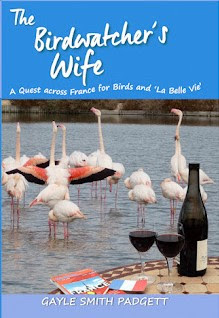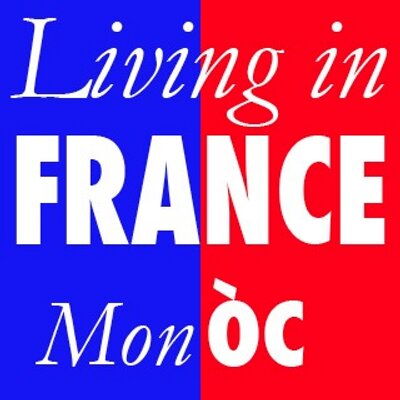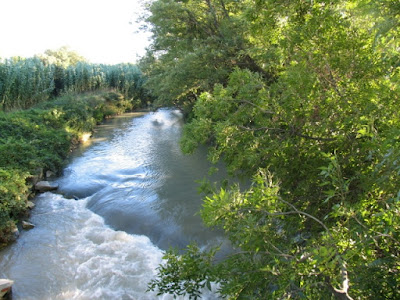For a couple years I had heard there was an American living in
Noves, a small village roughly 15 minutes from my home in St. Remy. Not that
there aren’t plenty of Americans around but most are on vacation or have second
homes; not so many stick around all year. “So who’s the American in
Noves?” I asked my friends at lunch one day. “Oh, that’s Gaby!” they said. “You
have to meet her!” I sent an email, Gaby said please come visit and we’ve been
great friends ever since.
Gaby's partner Guy is the owner of Le Moulin de la Roque,
a beautiful and very-unique estate on the site of a former flour mill
dating to the 15th century.
The property has a vast garden, a large Roman-style pool and several lovely historic
homes for holiday rentals. They call their place “a little Provençal village”
but that doesn’t really convey the “wow” I found when I first ambled up the
tree-lined lane. I could see immediately why travelers come back here year
after year…and knew immediately I wanted to write about it.
Le Moulin de la Roque sits deep in the countryside, a short walk
from the village, in an area known as La Roque (meaning cliff, in Old French). Nine separate accommodations--all
renovated from existing historic buildings which once served the mill in one
way or another--range from a small studio apartment to an eight-bedroom home. There’s a pétanque court, badminton,
volleyball, two large trampolines and plenty of safe space for kids to run
around. The beautifully landscaped 12-acre estate nestles up to a rocky,
forested cliff (with 750 acres of hiking trails) and is bordered by the pretty Anguillon River, which fed water to
the mill for hundreds of years. It’s all very secluded but just a five minute
walk from the closest boulangerie for your morning croissants. The old mill is
still largely intact. (For more about the property’s history, click here.)
For 400 years or so, this was one of the most prominent properties
in the region. Twenty-five years or so years ago it was a total ruin.
And that’s where our story begins! That’s when Guy Fallon, his
then-wife Christine and their three kids came down from Belgium, looking for a
slower, sweeter life and a two-year sabbatical from Guy’s career as an
oil trader for Petrofina.
Trained as an engineer and passionate about the outdoors, hiking
and adventure, Guy originally thought they’d spend their break in the Alps or near Lake
Annecy. “But every time we went house hunting, it was pouring rain or snowing
like crazy in either place,” he remembers. “And
every-time we visited friends in Provence, the weather was absolutely
beautiful. It was Christine who finally said ‘Why don’t we try Provence
instead?’’’
The last thing the couple visualized was buying an abandoned
500-year-old mill and undertaking a massive restoration project. But when Guy
laid eyes on the old property...well you know already how that went. The
land was very green and lush, home to a small vineyard and some 1500 quince
trees, and Guy loved the idea of agriculture. The still-intact mill appealed to
Guy’s engineering side...and the kids could attend good schools in nearby
Avignon. Plus, the property seemed to have infinite potential.
Back in the day, at the peak of production, eight full time
millers were producing seven tons
of flour here per day, as well as
electricity for themselves and part of the village. The Roux family, which had bought the property in 1682,
grew very wealthy from milling and when they rebuilt the manor house in 1910,
they gilded the balconies with real gold. “They became a little bit fancy,” Guy
says, “and called their home Château de la Roque. They were a bit showy but the
property was definitely industrial.”
Flour production ceased in 1962 and the mill began producing
electricity exclusively. That ended in 1977, when a stone dam on the river was destroyed to
prevent flooding, leaving nothing to power the mill. As various Roux family
members died or became estranged, the property fell into disrepair and they
finally sold it in 1984. There were two subsequent owners and when Guy bought it ten years later, all the rustic outbuildings
were crumbling: a tuilerie or large stone kiln for making
terracotta roof tiles (tuiles), a bergerie (sheep barn), a large
building for storing grain, a miller’s cottage. Along with the purchase
Guy inherited an alcoholic caretaker, which somehow lent to the charm
(until it didn’t).
When Guy signed the contract in 1994, his mom—having being raised in
old Belgian châteaux with always-leaky roofs--proclaimed “Guy! Are you crazy?
You bought too much roof!” Today he says he’s in total agreement!
The first order of business was the orchard and Guy set out to
learn everything he could about quince. “It’s very unusual in Provence to
cover a field with quince trees,” he reports. “It’s a very old-fashioned tree
and the market for the fruit is narrow. But since the trees were already there,
I figured I might as well do something with them. I told myself, how hard can
it be? Selling a barrel of oil or a ton of quince...same thing...it's just
selling!"
Guy dove into quince farming with abandon, doubling production his first year.
Which of course led to the next problem: what to do with 36,000 kilos of
quince? "I had absolutely no idea who’d buy them," he remembers.
"I now knew how to grow and treat them but had no idea how to pick or sell
them."
So Guy’s caretaker asked around at the local cafe and “five drunk
guys” came to help. Together they haphazardly harvested the fruit, Guy watching
in horror as they tossed quince from one to the other, dropping most on the
ground. And then off Guy went off to the wholesale food market in nearby
Châteaurenard, the biggest in the region, his ancient tractor and trailer overflowing
with quince. Only then did it become apparent what a true outsider he was: a city slicker and gentleman farmer who—word had it—was actually a Baron back in
Belgium (true).
"I was not of this world!" he says, laughing.
"There were 5,000 trucks there...and just two of us on tractors: an old
guy who looked like he would die any minute and one crazy Belgian."
Soon Guy hired a more-professional crew and the word spread that the crazy
Belgian in Noves was producing lots of beautiful fruit. That’s when he
got a call from a wholesaler in Pernes la Fontaine, 30 minutes away by car. “He
wanted three tons of quince in one go...quite tempting!” Guy remembers. “I was
picking two tons a day, more or less, and if you don’t sell them within two or
three days, you have a warehouse full of quince. He offered me an extra
franc per kilo but only if I’d deliver. But all I had was my ancient tractor! To go 25 or 30 km on a two-ton tractor, with three tons of fruit behind you and no brakes, is totally stupid but of course I did it:
across the river...across the big bridge...down the big N900 towards Apt, one
of the busiest roads around... then down a big hill...no way to stop...and all
that fruit behind me. And then every day the same guy wanted the same tonnage,
so I did it over and over again. It was really, really dangerous.”
Guy eventually bought an old truck and quickly became the
biggest quince-grower in Provence, producing 50,000 kilos each year. And then
after seven or eight years of quince-shlepping, the royal Belgian farmer said basta...he was ready for a new
challenge.
Guy had already begun to think about renovating the property and
as many other farmers in the area were renting farmhouses to summer travelers,
he thought, “why not?” Christine, on the other hand, decided the “Green Acres”
life with paying guests was definitely not for her. So she moved to Avignon,
the kids stayed at the Moulin with Guy, and the couple divorced in 1998.
From that point on, Guy went full steam ahead, transforming the
property for tourism. “I read A
Year in Provence like
everyone else,” he recalls, “and I knew how complicated a large project
like this was going to be.” With a cranky local “builder” he renovated three
houses over three years, repairing old broken stone walls and transforming the
interiors into beautiful homes. Fairly rustic at the beginning, the
houses got nicer and nicer as time went on. Guests came...and came back...and
brought their friends. Traveling couples loved the relaxed atmosphere and
authenticity of the “real Provence,” while families loved the space and the activities
for kids. Painters found the property to be the perfect backdrop for art
workshops.
In 2002, Gaby Janney showed up from Virginia, a guest in one of
these workshops. Turns out Gaby was having her own mid-life crisis—similar
to Guy’s ten years before--and she was hoping that some painting time in Provence would offer a nice reprieve. “I was in a big
transition and I came to France to lighten up my life a bit,” she explains. So
the pretty blonde American landed in Provence, all set for her restorative
vacation, but her luggage never turned up. As Gaby had no transportation and
spoke no French at the time, Guy the charming host jumped into action: taking
her shopping, calling the airline, doing everything he could to help.
Gaby fell quickly in love: with the property, with the region and
with Guy.
With a background in business and marketing, Gaby’s passions have
now shifted to Provence and all that it offers: from fabrics, cuisine,
antiques, decorating and art to the people, culture and history of rural
France. She loves to share her knowledge with guests; she herself is a
painter and she enthusiastically welcomes artists and workshops on the estate.
A few weeks ago, Gaby and Guy invited me for dinner by the fire in
the house they call Mas des Oliviers...and I mentioned that I loved the old
wood they had used to top a high kitchen counter. “These planks were part of an
old barge that I found in a field and dragged home,” Gaby told me. “The workers
thought I was nuts when I told them what I wanted them to do with it!
“Everything here is historic and original,” she continued. “We’ve
done no new construction at all. We use old materials wherever possible to keep
the traditional Provencal charm and style.”
The various layouts and sizes of the accommodations make
Moulin de la Roque a terrific option for large family vacations and other
gatherings that require lots of rooms. The largest house (eight bedrooms,
seven baths) has a large atelier perfect for workshops, reunions, meetings and receptions.
Whereas guests stay in typical Provencal farmhouses or cottages,
Gaby and Guy’s house –the one the Roux family and the villagers called a
château—is more noble, the type of grand Bourgeois home commonly built by
wealthy families in cities such as Avignon or Aix. Dating to 1910, it has
soaring ceilings, Italian marble, mosaics and beautiful tile floors, all done
in the Art Nouveau style which was very in vogue at the time.
In the area surrounding Moulin de la Roque, the late afternoon sun
is dazzling as it bathes vineyards, orchards and olive groves in light; biking
in the area is fabulous. In the early evening, guests love to hike up the hill
to see the sunset, gathering wild rosemary and thyme.
Guy and Gaby welcome all guests personally, with a fresh seasonal
tarte, a nice bottle of rosé, a tour of the property and a where-to-go guide
filled with their favorite “secret” places. They often host weekly cocktail parties which allow guests
from all over the world to mingle. A huge number of guests are repeats, including
some who met here originally and now schedule their trips to coincide.
When Guy’s daughter was married here two years ago, the Priest
came from Belgium and brought a white dove to be released during the ceremony.
But instead of flying off as he was supposed to, he decided to stick around.
Given the name Bello, he's now a pet and the happy mascot of
the Moulin. Which is of course just perfect, given Gaby and Guy's motto of warm
hospitality: “Arrive as a
guest, leave as friends or don’t leave at all!”
Moulin de la Roque is just a 20- to 30-minute drive from many of
the most-interesting, most-popular sites in Provence: the Luberon,
Avignon and the Palace of the Popes; Châteaufneuf-du-Pape and the
Southern Côtes du Rhône wine region; the Pont du Gard, Arles and Les Baux. It’s
45 minutes from Aix and just over an hour from the Camargue and charming
seaside Cassis.
For more info, see the website here, their TripAdvisor page here or email: moulinprovence@gmail.com.




























































.jpg)









































